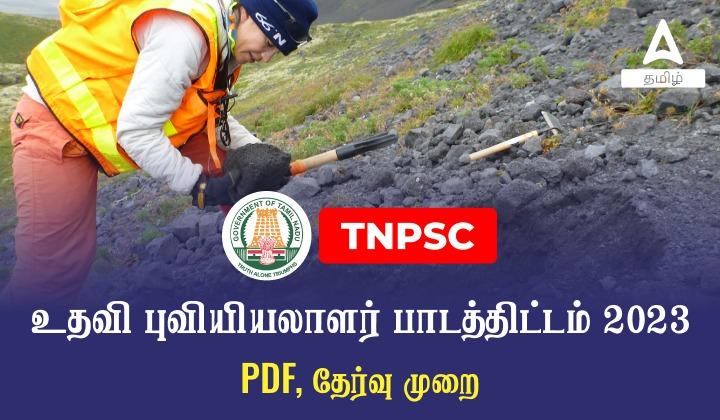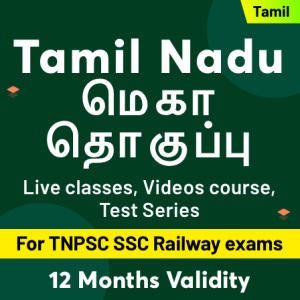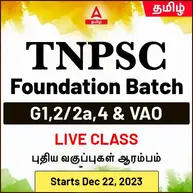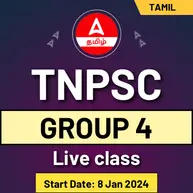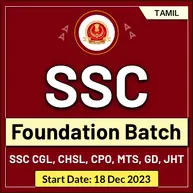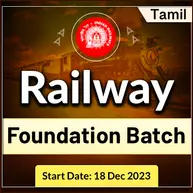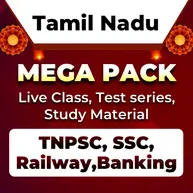Table of Contents
TNPSC உதவி புவியியலாளர் பாடத்திட்டம் 2023: தமிழ்நாடு அரசுப் பணியாளர் தேர்வாணையம் TNPSC உதவி புவியியல் அறிவிப்பை வெளியிட்டது மற்றும் TNPSC உதவி புவியியலாளர் தேர்வு ஆகஸ்ட் 18, 2023 அன்று நடத்தப்படும். TNPSC உதவி புவியியல் பாடத்திட்டம் 2023 மற்றும் தேர்வு முறை ஆகியவற்றைத் தயாரிப்பைத் தொடங்குவதற்கு முன் தெரிந்து கொள்வது அவசியம்.
இந்த கட்டுரையில், TNPSC உதவி புவியியலாளர் தேர்வு முறை மற்றும் பாடத்திட்டம் 2023 பற்றி விவாதிக்க உள்ளோம். மேலும், TNPSC உதவி புவியியலாளர் பாடத்திட்டம் PDF மற்றும் தேர்வு முறை பதிவிறக்கம் செய்வதற்கான இணைப்பு கீழே கொடுக்கப்பட்டுள்ளது.
TNPSC உதவி புவியியலாளர் பாடத்திட்டம் 2023 கண்ணோட்டம்
இந்தக் கட்டுரையில் TNPSC உதவி புவியியலாளர் Syllabus மற்றும் TNPSC உதவி புவியியலாளர் Exam Pattern மற்றும் TNPSC உதவி புவியியலாளர் Syllabus 2023 PDF ஆகியவற்றின் நேரடி பதிவிறக்க இணைப்பு உள்ளது. விண்ணப்பதாரர்கள் தங்கள் வெற்றிக்கான வாய்ப்புகளை அதிகரிக்க பாடத்திட்டத்தை முழுமையாகப் புரிந்து கொண்ட பிறகு தேர்வுத் தயாரிப்பைத் தொடங்குமாறு அறிவுறுத்தப்படுகிறார்கள்.
|
TNPSC உதவி புவியியலாளர் பாடத்திட்டம் 2023 |
|
|
நிறுவனம் |
தமிழ்நாடு அரசு பணியாளர் தேர்வாணையம் |
|
பதவியின் பெயர் |
40 உதவி புவியியலாளர் (ஒருங்கிணைந்த புவியியல் துணை சேவை தேர்வு) பதவிகள் |
கட்டுரை வகை
|
பாடத்திட்டம் மற்றும் தேர்வு முறை |
|
TNPSC உதவி புவியியலாளர் தேர்வு முறை |
கணினி அடிப்படையிலானது |
|
TNPSC உதவி புவியியலாளர் தேர்வு மொழி |
தமிழ் & ஆங்கிலம் |
| அதிகாரப்பூர்வ இணையதளம் | https://www.tnpsc.gov.in/ |
TNPSC உதவி புவியியலாளர் பாடத்திட்டம் 2023
TNPSC உதவி புவியியலாளர் பாடத்திட்டம் – Paper 1
கீழே உள்ள TNPSC உதவி புவியியலாளர் அறிவிப்பு பாடத்திட்டத்தை
சரிபார்க்கவும்.
| TNPSC உதவி புவியியலாளர் பாடத்திட்டம் 2023 |
|
| UNIT I – GENERAL GEOLOGY AND GEOMORPHOLOGY | Origin, Evolution, Age and Interior of the Earth – Principles of geodesy – Rock cycle – Isostasy – Continental drift, Seafloor spreading, Plate tectonics – Paleomagnetism and its application for determining paleoposition of continents – Orogeny and Epeirogeny – Volcanoes and earthquakes – Effects and causes – Seismic Hazard zonation of India – Tectonic deformation and seismicity in the Extra Peninsular, Indogangetic plains and Peninsular India – Applications of geomorphology in mineral prospecting and coastal studies – Weathering – processes and products – Geomorphic cycles and their interpretation – Morphology and its relation to structures and lithology – geomorphic landforms formed by action of rivers, wind, glaciers, waves and groundwater – Features of ocean floor – continental shelf, slope and rise – concepts of landscape evolution, major geomorphic features of India – coastal, peninsular and extra peninsular – Classification of shorelines and their evolution – submarine canyons, Geosynclines and Island arcs. |
| Unit II – STRATIGRAPHY | Principles of stratigraphy – Code of stratigraphic nomenclature of India – lithostratigraphy – biostratigraphy – chronostratigraphy – magnetostratigraphy, sequence stratigraphy – Principles of stratigraphic correlation; Indian stratigraphy and economic importance – Cratons of India – Dharwar, Bastar, Singhbhum, Aravalli and Bundelkhand Cratons – Proterozoic mobile belts – Eastern Ghats Mobile Belt, Southern Granulite Terrain, Central Indian Tectonic Zone, Aravalli – Delhi Belt, North Singhbhum Mobile Belt – Proterozoic sedimentary basins – Cuddapah, Delhi, Vindhyan, Kurnool and Kaladgi – Phanerozoic stratigraphy – Paleozoic – Spiti, Kashmir and Kumaon – Mesozoic – Spiti, Kutch, Narmada Valley and Tiruchirapalli erstwhile Trichinopoly – Gondwana Supergroup, Deccan Traps – Cenozoic Assam, Bengal basins, Garhwal-Shimla Himalayas – Siwaliks – boundary problems in Indian stratigraphy Precambrian-Cambrian boundary – Permian-Triassic boundary – Cretaceous-Paleogane (K-Pg) formerly Cretaceous-Tertiary (K-T) boundary – Paleogane-Neogene and Neogene-Quaternary boundary. |
| Unit III PALEONTOLOGY | Fossil record and geological time scale – modes of preservation of fossils and concept of taphonomy – Body and ichno-fossils, species concept, organic evolution, Ediacara Fauna – morphology and time range of Graptolites, Trilobites, Brachiopods, Lamellibranchs, Gastropods, Cephalopods, Echinoids and Corals – Evolutionary trends in Trilobites, Gastropods, Cephalopods; and Graptolites – Micropaleontology – methods of preparation of microfossils, morphology of microfossil groups (Foraminifera, Ostracoda), Fossil spores and pollen – Application of micropaleontology in oil exploration – Gondwana plant fossils and their age and climate significance – Vertebrate life through ages, evolution in Proboscidea, Equidae and Hominidae – Dinosaurs – their classification and extinction – Applications of paleontological data in stratigraphy, paleoecology, and paleoclimatology – Mass Extinctions. |
| Unit IV STRUCTURAL GEOLOGY | Mechanical principles of rocks – Strain markers in deformed rocks – Mohr’s circle – V rules and outcrop patterns – Stereographic Projections of structural elements – Mechanics and causes of folding and faulting – Classification of folds and faults – Recognition of folds and faults in the field – Joints – Cleavage and Schistosity types and origin – Secondary lineation – Types of unconformity and their recognition in the field – Introduction to Petrofabric analysis – Tectonites, their classification and geological significance. |
| Unit V MINERALOGY AND CRYSTALLOGRAPHY | Definition, Classification and elements of minerals and Crystallography – Optical, Electrical and Magnetic Properties of minerals – Physical, chemical and optical properties of Quartz, Feldspars, Feldspathoids, Pyroxene, Amphibole, Olivine, Garnet, Mica, Zeolites and Carbonate groups – Stereographic and Gnomonic projections of natural crystals of normal classes. 14 Bravais lattices and their derivation – Derivation of 32 classes of symmetry – Elements of X-ray crystallography – Napier’s theorem – Equations of a normal – Bragg’s law – X-ray diffraction method – Identification of minerals from X-ray diffractogram – Concept of optical mineralogy – Identification of minerals using petrological microscope. |
| Unit VI IGNEOUS AND METAMORPHIC PETROLOGY | Classification of Igneous rocks: Mineralogical, Chemical and IUGS classification – Structures and textures – Petrography and petrogenesis of Granites, Alkaline rocks, Anorthosites, Carbonatites, Dolerites, Ultramafics – Study of binary and ternary system of crystallisation – Bowen’s reaction series – Diversity of Igneous rocks – variation diagrams – Crystallisation of Basaltic magma – Metamorphism – Agents and kinds of metamorphism. |
| Unit VII SEDIMENTOLOGY | Sedimentary depositional environments – Important clastic and non-clastic rocks – Heavy minerals and Provenance – Tectonics and Sedimentation – Sedimentary Basins of India – Paleo currents and Basin Analysis – Classification of sedimentary rocks – sedimentary textures grains size, roundness, sphericity, shape and fabric – grain size analysis – sediment transport and deposition – sedimentary structures Pen contemporaneous deformation structure and biogenic structures – principles and application of paleo current analysis – composition and significance of different types of sedimentary rocks Sandstone, Limestone, Banded Iron Formation, Mudstone and Conglomerate – carbonate diagenesis and dolomitisation – sedimentary environments and facies-facies models – fluvial, glacial, deltaic, siliciclastic shallow and deep marine environments – carbonate platforms – types and facies models; sedimentation in major tectonic settings; Application of sequence stratigraphy in basin analysis. |
| Unit VIII ECONOMIC GEOLOGY | Classification of mineral deposits – Process of formation of mineral deposits – Magmatic, Hydrothermal, Sedimentary, Metamorphic, Sublimation, Evaporation, Oxidation and Supergene enrichment – Metallogenic Epochs and provinces of India – Introduction of ore microscopy – Physical and optical properties of ore minerals – Textures and microstructures of ores – Controls of ore Localisation – Fluid inclusion in ore mineral assemblages – Origin, Occurrences, Indian distribution and uses of the following ores – Iron, Manganese, Copper, Lead, Zinc, Aluminium, Chromium, Gold, Barite, Graphite, Asbestos and Silica, Uranium, Thorium and Industrial Minerals. Origin of coal and petroleum – Physical and Chemical Properties of coal and petroleum – Deposits of coal and Petroleum in India – Distribution of Gondwana and Tertiary coal fields of India. Gas hydrates and Coal bed methane, Petroliferous basins of India – Lignite deposits in India – Strategic, Critical and essential minerals – National mineral policy 2019 – Conservation and Utilization of mineral resources. |
| Unit IX HYDROGEOLOGY | Occurrence of groundwater – Aquifers – Major Basins and Drainage systems of Tamil Nadu – Groundwater flow – Darcy’s Law – Hydraulic conductivity and Hydrological parameters – Transmissibility, Permeability – Specific yield and retention – Hydrogeological characters of different types of rocks – Rock water interaction – Types of wells – Drilling methods and methods of construction, Design and development and Well logging methods – Pumping test methods – Estimates of groundwater potential and recharge – Managed Aquifer recharge – Rainwater Harvesting techniques and methods – Aquifer recharge methods – Seawater intrusion – Study and methods – Electrical methods of groundwater exploration – Tracer – Isotope techniques. |
| Unit X APPLIED GEOLOGY | Geophysical methods of prospecting – Electrical, Magnetic, Gravity and Seismic – Radioactive methods – Geochemical classification of elements and anomaly – Geochemical cycle – Geochemical prospecting – Engineering properties of Rocks – Geological investigations pertaining to Dams, Reservoirs, Tunnels, Bridges and Roads – Rock sampling techniques – Ore reserve estimation and UNFC. Mining Methods: Surface and Sub surface – Coal and Alluvial – Prominent mines and mineral legislations of India – Environmental impacts (EIA) due to mining and mineral processing – Role of Geologist in mining industries. Natural Hazards – Floods, Landslides, Earthquakes and Tsunami – Causes and Mitigation. Renewable and non renewable resources. Applications of Remote sensing – GIS and GPS in Geological studies classification of metamorphic Rocks – Textures and Structures – Different grades and depth Zones – Metamorphic facies – Metamorphic differentiation – Thermal – Clastic and Regional Metamorphism – Origin of Eclogites – Charnockitisation – Granitisation – Metasomatism. |
PAPER -II
SYLLABUS FOR WRITTEN EXAMINATION
Part-A
- பிரித்தெழுதுதல் / சேர்த்தெழுதுதல்.
- எதிர்ச்சொல்லை எடுத்தெழுதுதல்.
- பொருந்தாச் சொல்லைக் கண்டறிதல்.
- பிழைதிருத்தம் (i) சந்திப்பிழையை நீக்குதல் (ii) மரபுப்பிழைகள், வழுவுச் சொற்களை நீக்குதல் /பிறமொழிச் சொற்களை நீக்குதல்.
- ஆங்கிலச் சொல்லுக்கு நேரான தமிழ்ச் சொல்லை அறிதல்
- ஒலி மற்றும் பொருள் வேறுபாடறிந்து சரியான பொருளையறிதல்.
- ஒரு பொருள் தரும் பல சொற்கள்.
- வேர்ச்சொல்லைத் தேர்வு செய்தல்.
- வேர்ச்சொல்லைக் கொடுத்து / தொழிற்பெயரை / உருவாக்கல். வினைமுற்று, வினையெச்சம், வினையாலணையும் பெயர்,
- அகரவரிசைப்படி சொற்களை சீர் செய்தல்.
- சொற்களை ஒழுங்குப்படுத்தி சொற்றொடராக்குதல்
- இரு வினைகளின் பொருள் வேறுபாடு அறிதல்.(எ.கா.) குவிந்து-குவித்து
- விடைக்கேற்ற வினாவைத் தேர்ந்தெடுத்தல்
- எவ்வகை வாக்கியம் எனக் கண்டெழுதுதல் – தன்வினை, பிறவினை, செய்வினை, செயப்பாட்டு வினை வாக்கியங்களைக் கண்டெழுதுதல்.
- உவமையால் விளக்கப்பெறும் பொருத்தமான பொருளைத் தேர்ந்தெழுதுதல்
- அலுவல் சார்ந்த சொற்கள் (கலைச்சொல்)
- விடை வகைகள்.
- பிறமொழிச் சொற்களுக்கு இணையான தமிழ்ச் சொற்களைக் கண்டறிதல் (எ.கா.) கோல்டு பிஸ்கட் – தங்கக்கட்டி.
- ஊர்ப் பெயர்களின் மரூஉவை எழுதுக (எ.கா.) தஞ்சாவூர் – தஞ்சை
- நிறுத்தற்குறிகளை அறிதல்.
- பேச்சுவழக்கு, எழுத்துவழக்கு (வாரான் – வருகிறான்).
- சொற்களை இணைத்து புதிய சொல் உருவாக்கல்
- பொருத்தமான காலம் அமைத்தல்(இறந்தகாலம், நிகழ்காலம், எதிர்காலம்).
- சரியான வினாச்சொல்லைத் தேர்ந்தெடு.
- சரியான இணைப்புச் சொல்(எனவே, ஏனெனில், ஆகையால், அதனால், அதுபோல).
- அடைப்புக்குள் உள்ள சொல்லைத் தகுந்த இடத்தில் சேர்க்க.
- இருபொருள் தருக.
- குறில் – நெடில் மாற்றம், பொருள் வேறுபாடு.
- கூற்று, காரணம் – சரியா? தவறா?
- கலைச் சொற்களை அறிதல் :-எ.கா. – Artificial Intelligence – செயற்கைநுண்ணறிவு Super Computer – மீத்திறன் கணினி
- பொருத்தமான பொருளைத் தெரிவு செய்தல்
- சொற்களின் கூட்டுப் பெயர்கள் (எ.கா.) புல் –புற்கள்
- சரியான தொடரைத் தேர்ந்தெடுத்தல்
- பிழைதிருத்துதல் (ஒரு-ஓர்)
- சொல் – பொருள் – பொருத்துக
- ஒருமை-பன்மைபிழை
- பத்தியிலிருந்து வினாவிற்கான சரியான விடையைத் தேர்ந்தெடு.
| PAPER – II – Part – B GENERAL STUDIES (DEGREE STANDARD) |
|
| UNIT-I: GENERAL SCIENCE | (i) Scientific Knowledge and Scientific Temper – Power of Reasoning – Rote Learning vs Conceptual Learning – Science as a tool to understand the past, present and future. (ii) Nature of Universe – General Scientific Laws – Mechanics – Properties of Matter, Force, Motion and Energy – Everyday application of the Basic Principles of Mechanics, Electricity and Magnetism, Light, Sound, Heat, Nuclear Physics, Laser, Electronics and Communications. (iii) Elements and Compounds, Acids, Bases, Salts, Petroleum Products, Fertilisers, Pesticides. (iv) Main concepts of Life Science, Classification of Living Organisms, Evolution, Genetics, Physiology, Nutrition, Health and Hygiene, Human Diseases. (v) Environment and Ecology. |
| UNIT-II: CURRENT EVENTS | (i) History – Latest diary of events – National symbols – Profile of States – Eminent personalities and places in news – Sports – Books and authors. (ii) Polity – Political parties and political system in India – Public awareness and General administration – Welfare oriented Government schemes and their utility, Problems in Public Delivery Systems. (iii) Geography – Geographical landmarks. (iv) Economics – Current socio – economic issues. (v) Science – Latest inventions in Science and Technology. (vi) Prominent Personalities in various spheres – Arts, Science, Literature and Philosophy. |
| UNIT-III: GEOGRAPHY OF INDIA | (i) Location – Physical features – Monsoon, Rainfall, Weather and Climate – Water Resources – Rivers in India – Soil, Minerals and Natural Resources – Forest and Wildlife – Agricultural pattern. (ii) Transport – Communication. (iii) Social Geography – Population density and distribution – Racial, Linguistic Groups and Major Tribes. (iv) Natural calamity – Disaster Management – Environmental pollution: Reasons and preventive measures – Climate change – Green energy. |
| UNIT–IV: HISTORY AND CULTURE OF INDIA | (i) Indus Valley Civilization – Guptas, Delhi Sultans, Mughals and Marathas – Age of Vijayanagaram and Bahmani Kingdoms – South Indian History. (ii) Change and Continuity in the Socio-Cultural History of India. (iii) Characteristics of Indian Culture, Unity in Diversity – Race, Language, Custom. (iv) India as a Secular State, Social Harmony. |
| UNIT-V: INDIAN POLITY | (i) Constitution of India – Preamble to the Constitution – Salient features of the Constitution – Union, State and Union Territory. (ii) Citizenship, Fundamental Rights, Fundamental Duties, Directive Principles of State Policy. (iii) Union Executive, Union Legislature – State Executive, State Legislature – Local Governments, Panchayat Raj. (iv) Spirit of Federalism: Centre – State Relationships. (v) Election – Judiciary in India – Rule of Law. (vi) Corruption in Public Life – Anti-corruption measures – Lokpal and Lok Ayukta – Right to Information – Empowerment of Women – Consumer Protection Forums, Human Rights Charter. |
| UNIT-VI: INDIAN ECONOMY | (i) Nature of Indian Economy – Five year plan models – an assessment – Planning Commission and Niti Ayog. (ii) Sources of revenue – Reserve Bank of India – Fiscal Policy and Monetary Policy – Finance Commission – Resource sharing between Union and State Governments – Goods and Services Tax. (iii) Structure of Indian Economy and Employment Generation, Land Reforms and Agriculture – Application of Science and Technology in Agriculture – Industrial growth – Rural Welfare Oriented Programmes – Social Problems – Population, Education, Health, Employment, Poverty. |
| UNIT-VII: INDIAN NATIONAL MOVEMENT | (i) National Renaissance – Early uprising against British rule – Indian National Congress – Emergence of leaders – B.R.Ambedkar, Bhagat Singh, Bharathiar, V.O.Chidambaranar Jawaharlal Nehru, Kamarajar, Mahatma Gandhi, Maulana Abul Kalam Azad, Thanthai Periyar, Rajaji, Subash Chandra Bose, Rabindranath Tagore and others. (ii) Different modes of Agitation: Growth of Satyagraha and Militant Movements. (iii) Communalism and Partition. |
| UNIT-VIII: History, Culture, Heritage and Socio – Political Movements in Tamil Nadu |
(i) History of Tamil Society, related Archaeological discoveries, Tamil Literature from Sangam Age till contemporary times. (ii) Thirukkural : (a) Significance as a Secular Literature (b) Relevance to Everyday Life (c) Impact of Thirukkural on Humanity (d) Thirukkural and Universal Values – Equality, Humanism, etc (e) Relevance to Socio – Politico – Economic affairs (f) Philosophical content in Thirukkural (iii) Role of Tamil Nadu in freedom struggle – Early agitations against British Rule – Role of women in freedom struggle. (iv) Evolution of 19th and 20th Century Socio-Political Movements in Tamil Nadu – Justice Party, Growth of Rationalism – Self Respect Movement, Dravidian Movement and Principles underlying both these Movements, Contributions of Thanthai Periyar and Perarignar Anna. |
| UNIT–IX: Development Administration in Tamil Nadu | (i) Human Development Indicators in Tamil Nadu and a comparative assessment across the Country – Impact of Social Reform Movements in the Socio – Economic Development of Tamil Nadu. (ii) Political parties and Welfare schemes for various sections of people – Rationale behind Reservation Policy and access to Social Resources – Economic trends in Tamil Nadu – Role and impact of social welfare schemes in the Socio – Economic Development of Tamil Nadu. (iii) Social Justice and Social Harmony as the Cornerstones of Socio-Economic Development. (iv) Education and Health Systems in Tamil Nadu. (v) Geography of Tamil Nadu and its impact on Economic growth. (vi) Achievements of Tamil Nadu in various fields. (vii) e-Governance in Tamil Nadu. |
| UNIT-X: APTITUDE AND MENTAL ABILITY | (i) Simplification – Percentage – Highest Common Factor (HCF) – Lowest Common Multiple (LCM). (ii) Ratio and Proportion. (iii) Simple interest – Compound interest – Area – Volume – Time and Work. (iv) Logical Reasoning – Puzzles-Dice – Visual Reasoning – Alpha numeric Reasoning – Number Series. |
TNPSC உதவி புவியியலாளர் தேர்வு முறை 2023
-
தாள் – I இல் உள்ள கேள்விகள் ஆங்கிலத்தில் மட்டுமே அமைக்கப்படும் மற்றும் தாள் – II இல் பகுதி B க்கான கேள்விகள் ஆங்கிலம் மற்றும் தமிழில் அமைக்கப்படும். தாள்-II தமிழ் தகுதித் தேர்வின் பகுதி-A 1 முதல் 100 வரை 100 கேள்விகளைக் கொண்டிருக்க வேண்டும்.
-
தாள்-II இன் பகுதி-B 101 முதல் 200 வரை 100 கேள்விகளைக் கொண்டுள்ளது மற்றும் மேற்கூறிய தேர்வின் ஒவ்வொரு பகுதியையும் எழுதுவதற்கான கால அளவு 1 மணி நேரம் 30 நிமிடங்கள் கொடுக்கப்பட்டது.
| Subject | Duration | Maximum marks | Minimum qualifying marks for selection | |
| SCs, SC(A)s, STs, MBCs/DCs BC(OBCM)s & BCMs | Others | |||
| Paper –I:- Geology (Code No.395) (PG Degree Standard) (200 Questions) | 3 Hours | 300 | 153 | 204 |
| Paper – II:- Part-A Tamil Eligibility Test (SSLC Standard) (100 questions/150 marks) | 3 Hours | 150 Note: Minimum qualifying marks – 60 marks (40% of 150) Marks secured in Part-A of Paper-II will not be taken into account for ranking. | ||
| Part-B (General Studies)(Code No:003) (100 questions/150 marks) General Studies (Degree Standard–75 questions) and Aptitude and Mental Ability Test (SSLC Standard-25 questions)
Interview and Records |
150
60 |
|||
| Total | 510 | |||
TNPSC உதவி புவியியலாளர் பாடத்திட்டம் 2023 PDF
TNPSC உதவி புவியியலாளர் பாடத்திட்டம் 2023 பாடத்திட்டத்தில் மேலே குறிப்பிடப்பட்ட தலைப்புகள் தொடர்பான கேள்விகள் இருக்கும். விண்ணப்பதாரர்கள் பாடத்திட்டத்தை முழுமையாக படித்து அதற்கேற்ப தயார் செய்து தேர்வில் நல்ல மதிப்பெண் பெற அறிவுறுத்தப்படுகிறார்கள். TNPSC உதவி புவியியலாளர் பாடத்திட்டத்தை PDF பதிவிறக்கம் செய்ய கீழே உள்ள இணைப்பை கிளிக் செய்யவும்.
|
TNPSC உதவி புவியியலாளர் ஆட்சேர்ப்பு 2023 PDF |
|
| TNPSC உதவி புவியியலாளர் ஆட்சேர்ப்பு 2023 PDF – Tamil | Click Here |
| TNPSC உதவி புவியியலாளர் ஆட்சேர்ப்பு 2023 PDF – English | Click Here |
***************************************************************************************
To Attempt the Quiz on APP with Timings & All India Rank,
Download the app now, Click here
Adda247 பயன்பாட்டில் இந்த வினாடி வினாவை முயற்சிக்க இங்கே கிளிக் செய்து அகில இந்திய தரவரிசையைப் பெறுங்கள்
| Adda247 TamilNadu Home page | Click here |
| Official Website=Adda247 | Click here |
***************************************************************************
*இப்போது உங்கள் வீட்டில் தமிழில் நேரடி வகுப்புகள் கிடைக்கின்றன*
*பயிற்சி மட்டுமே தேர்வுர உங்களுக்கு உதவ முடியும் | Adda247 தமிழ் மூலம் உங்கள் பயிற்சியை இப்போது தொடங்கவும்*
Adda247App | Adda247 Tamil Youtube
Tamil Engineering Classes by Adda247 Youtube link
Adda247 Tamil telegram group –Tnpsc sure shot selection group
Instagram = Adda247 Tamil

